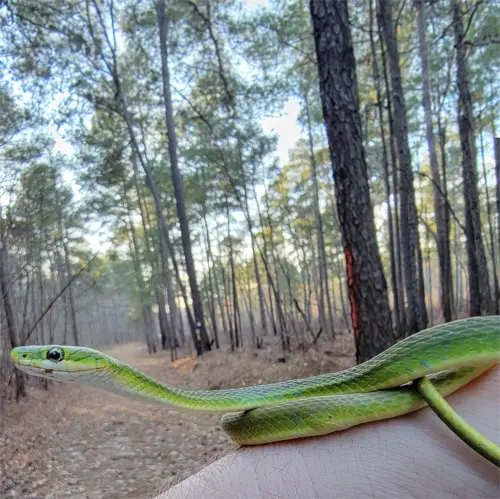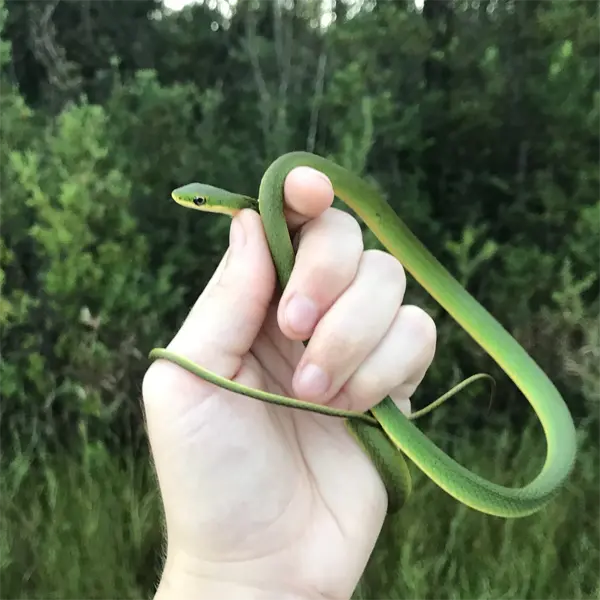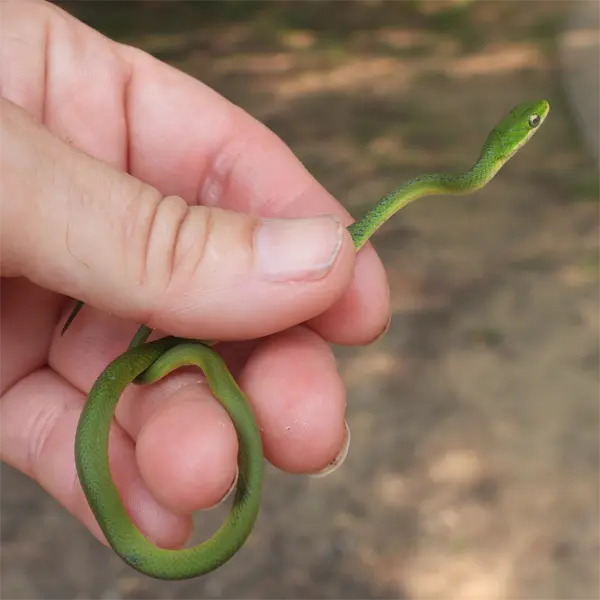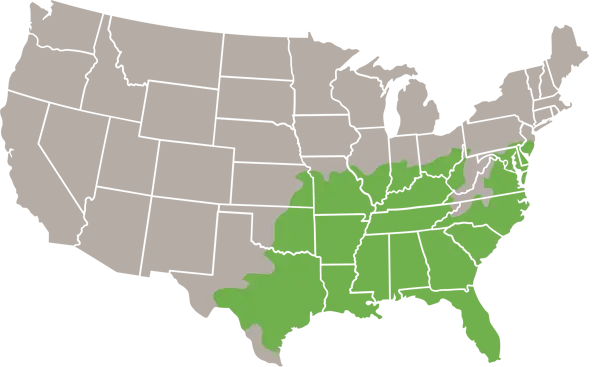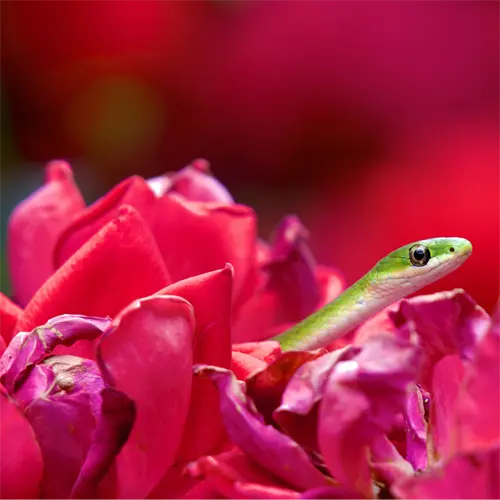Rough Green Snake
- Scientific Name
- Opheodrys aestivus
- Also Known As
- Rough Greensnake
- Range
- All of Florida
- Diet
- Insects, Spiders, Snails, Lizards
- Life Expectancy
- 5 Years
Quick Links
Rough Green Snakes in Central Florida
The rough green snake (Opheodrys aestivus) is a slender, vibrantly-colored colubrid species found throughout the southeastern United States, including central Florida. Often mistaken for a vine due to their green coloration, rough green snakes are non-venomous and generally docile.
This guide covers key identification features, biology, habitat preferences, diet, and bite risk of rough green snakes for central Florida residents.
Appearance and Identification
Rough green snakes can be identified by the following unique characteristics
Rough green snakes can be confused with the smooth green snake (Opheodrys vernalis), which has a more eastern range. The smooth green snake has glossy, smooth dorsal scales compared to the rough green snake’s weakly keeled scales.
Maturation Rate
Rough green snakes grow quickly, more than doubling in size within their first year. They reach sexual maturity and adult length by ages 1-2.
Habits and Behavior
Rough green snakes are active during the day, often seen basking on vegetation in the morning. They are skilled climbers and swim well, sometimes found near water. When threatened, rough green snakes may vibrate their tails and release a foul-smelling musk from their cloaca. This musk can cause localized skin irritation if rubbed into cuts or eyes. Their docile nature means bites are very rare.
Rough green snakes are more solitary compared to other snakes. They flee potential threats. Males may combat other males during the breeding season. Overall they are timid, gentle snakes that tend to avoid confrontation.
Reproduction and Lifespan
Mating occurs in April-May in central Florida. Females lay clutches of 5-15 eggs in rotting vegetation or compost piles in June-August. The eggs hatch around September after an 8-10 week incubation. Hatchlings grow rapidly and reach maturity within 1-2 years.
Rough green snakes live approximately 5 years in the wild. Their small size and camouflage helps them evade most predators, although they may fall prey to birds of prey and other snakes. Major threats are habitat loss and human persecution due to mistaken identity with venomous serpents.
Ideal Habitat and Range
Central Florida’s warm, humid climate with abundant vegetation and water provides optimal rough green snake habitat. Average temperatures range from low 70sF (22C) in north Florida to the upper 70sF (25C) in south Florida. Hot summers see highs in the 90sF (30sC). Annual rainfall exceeds 50 inches (1270 mm).
Wooded areas, shrublands, swamps, marshes, and suburb gardens offer the mix of open sunny basking sites and shaded vegetation that rough green snakes favor. Rotting logs, compost piles, and moist soil provide cover. Lakes, ponds, and slow streams provide hydration, prey, and egg-laying sites.
Developed areas are readily colonized by rough green snakes if suitable vegetation is present. Gardens, parks, golf courses, and landscaped corporate campuses can all support rough green snake populations. Rural pastures, orchards, and timber plantations also provide habitat. Overall, central Florida offers ideal conditions for rough green snakes.
Diet and Feeding
Rough green snakes are carnivorous, feeding on small prey including:
- Insects – Grasshoppers, caterpillars, beetles, ants, wasps, and bees.
- Spiders
- Snails and slugs
- Lizards – Green anoles, skinks, geckos
- Frog eggs and tadpoles
Rough green snakes use vision to hunt during the day. They consume prey whole, subduing with constriction when needed. These opportunistic feeders drink water droplets off vegetation. Rough green snakes may vibrate their tail to lure inquisitive prey closer.
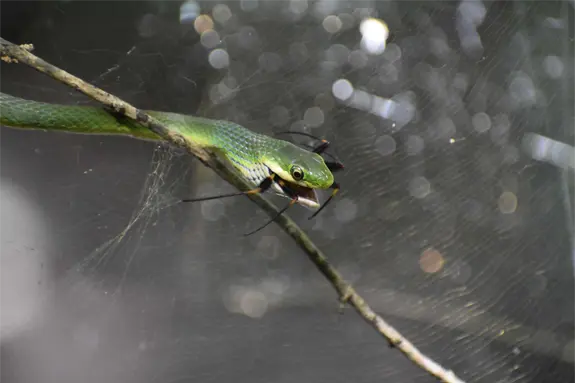
Photo 45574753 © Max Roberts, CC BY-NC

Common Health Risks
Rough green snakes are non-venomous and lack large fangs, posing minimal health risks to humans. Potential issues include:
- Bites – Rare and not medically significant. May cause minor localized swelling, irritation, or infection.
- Defensive musk – Can cause skin irritation, nausea if rubbed into eyes. Rinse thoroughly if exposed.
- Salmonellosis – Rough green snakes may harbor Salmonella bacteria like many reptiles. Wash hands after handling. Seek medical care if signs of infection appear.
Overall risks are low for these small, timid snakes. Bites requiring medical care are unlikely. Maintain basic hygiene precautions around any wild animal.
How to Protect the Rough Green Snake
Rough green snakes actually benefit gardens and homes by preying on pests like insects, spiders, snails, and rodents. Encourage natural populations through habitat provision:
- Maintain native vegetation, brush piles, and moist refuges.
- Supply clean water sources like garden ponds.
- Limit pesticide use which reduces the snake’s prey.
- Tolerate snakes found around the home and avoid killing.
- Seal entry points if snakes inside pose an issue. Install snake-proof fencing if needed.
- Contact professionals to remove and relocate snakes humanely if control is required.
Rough Green Snakes in Central Florida – Conclusion
The rough green snake is a welcome resident that controls pests. Their small size and docile nature mean they pose little risk to people and pets. Maintaining natural habitat helps conserve rough green snake populations amid development pressures in central Florida.
Through appreciation of these beneficial reptiles, rough green snakes and humans can continue to coexist throughout the region.

